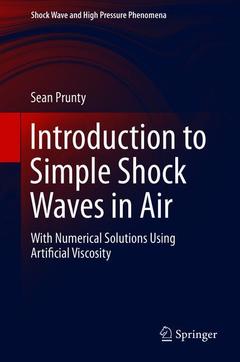Description
Introduction to Simple Shock Waves in Air, 1st ed. 2019
With Numerical Solutions Using Artificial Viscosity
Shock Wave and High Pressure Phenomena Series
Author: Prunty Seán
Language: English
Subject for Introduction to Simple Shock Waves in Air:
Publication date: 01-2019
Support: Print on demand
Support: Print on demand
Description
/li>Contents
/li>Biography
/li>Comment
/li>
This book provides an elementary introduction to some one-dimensional fluid flow problems involving shock waves in air. The differential equations of fluid flow are approximated by finite difference equations and these in turn are numerically integrated in a stepwise manner. Artificial viscosity is introduced into the numerical calculations in order to deal with shocks. The presentation is restricted to the finite-difference approach to solve the coupled differential equations of fluid flow as distinct from finite-volume or finite-element methods. This text presents the results arising from the numerical solution using Mathcad programming. Both plane and spherical shock waves are discussed with particular emphasis on very strong explosive shocks in air.
This text will appeal to students, researchers, and professionals in shock wave research and related fields. Students in particular will appreciate the benefits of numerical methods in fluid mechanics and the level of presentation.
Brief outline of the equations of fluid flow.- Waves of finite amplitude.- Conditions across the shock: the Rankine-Hugoniot equations.- Numerical treatment of plane shocks.- Spherical shock waves: the self-similar solution.- Numerical treatment of spherical shock waves.
Dr. Seán Prunty is a former senior lecturer in electrical and electronic engineering at University College Cork Ireland. He has a primary degree and a Ph.D. degree, both in experimental physics, from the University of Dublin, Trinity College. He has thirty years of teaching experience and has carried out research in such areas as atomic physics and laser technology as well as in far-infrared polarimetry and electromagnetic scattering for plasma physics applications. He collaborated for many years on research in the fusion energy research area in Italy, England and Switzerland. Since his retirement in 2009 he has taken a particular interest in shock wave propagation.
Helps solve nonlinear equations of fluid flow in the presence of shocks Includes results of numerical examples compared with theoretical predictions to solidify the concepts Results arise from the numerical solution using Mathcad
© 2024 LAVOISIER S.A.S.




